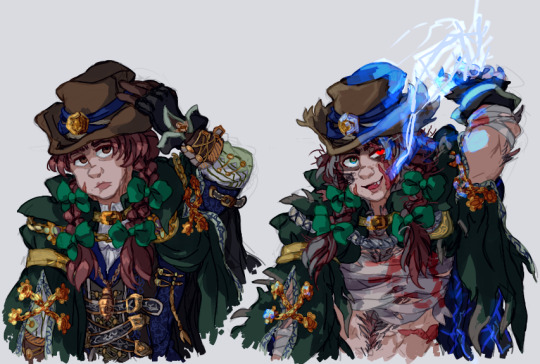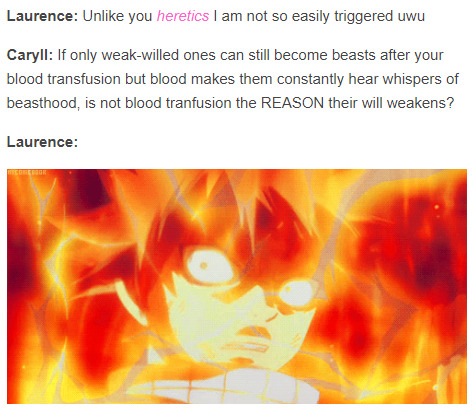#josef rebell
Text

Vesuvius Eruption at Night overlooking the Scuola di Virgilio, 1822
by Josef Rebell
#josef rebell#joseph rebell#vesuvius#art#mount vesuvius#mt vesuvius#vesuvio#volcano#volcanoes#italy#mediterranean#europe#european#eruption#eruptions#night#sky#moon#clouds#sea#moonlit#moonlight#full moon#waves#landscape#romantic#virgil#roman#ruins#naples
892 notes
·
View notes
Text

Details: Leuchtturm im Hafen von Neapel bei Mondschein, Josef Rebell, 1827
5 notes
·
View notes
Text
Centricide "Human Name" Headcannons
Like the countries in Hetalia have "real names" , I headcannon the ideologies in Centricide do (they are the names they used while mortal humans, I headcannon the Ideologies were once human people who died but then Jreg "revived" them and made them into supernatural immortal beings to represent each ideologies)
Commie - Vladimir Josefovich Marksov - a reference to Lenin, Stalin and Marx, it is Russian tradition that boys have (father's name)vich as their middle name, his father wasn't Stalin but was also called Josef
(((blueman))) - James Reichmanger - Jreg included this in a past video
Ancom - Arson/Jay Rivera - Jay was also included by Jreg in that sane video, Arson is a very stereotypical non binary name, qui aslo picked 2 names for quimself, quis deadname was the most basic white boy shit ever given by quis abusive father, Brutus, a western European alt right Catholic retvrn to trvadition man with a weird fetish for Crusaders, Quis mother was a Spanish woman who qui was close 2 as an infant until she "disappeared" according to Brutus. Ancom legally had quis Father's last name but then changed it to Rivera after finding long lost legal documents of quis mother, Brutus tried to remove all evidence of her existence after her "disappearance" hence why Ancom's DNA data was "100% aryan"
Ancap - Andrew Jack Cappy - this is acctually considered fully canon from Centricide 8 and not just directors cut, likes to go by AJ for short
Libertarian - Richard Pennybags - The only directors cut AU name most people actually use in Fanon , also gets called Rich for short ha you get it
Homofash - Adolfus Enrst Hancock - Adolfus is funny moustache man, Ernst see Centricide 6, Hancock has no suggestive meaning
AnQueer - Rebel - They rebel from gender norms and believe in abolishing last names and titles as well as gender
Anprim - Grug
AnMon - Rex Cavalier III
Posadist - Delphinus - Nobody knows weather he is actually an alien or severe radiation poisoning or they are just being ironic, hence nobody knows weather its his birth name or chosen name or weather they have a last name
MaxFem (Fanon Character) - Lyudmila Josefovna Marksova - Commie's little sister, his only "living" relative, I once read a Commie x Ancom fic where Commie is trying to tell his sister he is crushing on Ancom and then Posadist, who she is in an "its complicated" situationship with, gets involved and threatens Commie with nuking the Earth if he doesn't confess to Ancom
13 notes
·
View notes
Note
How many ladies-in-waiting did Empress Elisabeth have during her tenure as empress/queen?
Hi! I’m really glad I got this ask because lately I’ve been really interested in the people “behind the scenes” of Elisabeth’s life. But before answering this, we need to add some context and terminology, because “lady-in-waiting” is actually a very vague term.
First of all, who could access court?
The Habsburg court was extremely conservative on who could access it. While the courts of France or Prussia allowed the access of the rich bourgeoisie, to enter the Viennese court you needed to have an impecable noble background:
This small group of old nobility made up “court society”. They were the elite who passed all the tests of “ancestral lineage examination” with flying colours, who were permitted unlimited entry to court based on the pristine purity of their ancestral background. This exclusive group did not need to shine through achievement, it already possessed the requisite glamour from their heritage as princes, counts or barons. Whoever could prove eight maternal and paternal ancestors stemming from a noble line of flawless credentials and whose own ancestors had not broken this longstanding chain through marriages with partners beneath their standing could legitimately lay claim to the seal of approval generally dubbed ‘admissable at court’ (hoffähig). (Winkelhofer, 2012)
The women that were allowed to “wait” on the empress belonged to this exclusive group of nobles made up of about 400 families in the empire. “Rebel/low class woman infiltrates in court and becomes Elisabeth’s lady-in-waiting” is a trope that appeared in both RTL Sisi and Netflix Die Kaiserin, but that would’ve been simply impossible. There was a department in charge of checking everyone’s backgrounds, investigating every paper register and historical family tree. You either had the proper ancestry, or you weren’t allowed entrance.
So what was exactly the role of a “lady-in-waiting” at the Habsburg court?
There were two types of what we usually call “lady-in-waiting”: hofdamen (court ladies) and palastdamen (palaces ladies). Palastdamen were the aforementioned women who had access to court due to their noble status. Having access to court didn’t meant, however, that you just popped up at balls whenever you wanted. Even if you had an illustrious family tree you still needed to obtain official court recognition in order to be able to obtain a place at official occasions (for women, according to Winkelhofer, this was receiving the Order of the Starry Cross). Also Franz Josef was very strict on the nobility, and he demanded that nobles attended regularly at court to fulfill their duties; if someone didn’t appear in a long time they had to answer an inquiry as to why they had been absent, and the emperor could go as far as revoking their right to appear.
The compulsory duties of the nobility were, first, to pay their respects to the Emperor on 1st January at the New Year’s Day Reception, and later to attend to the two official balls that took place weeks later: the “Court Ball” and the “ball at court”. The next mandatory appearances were the holy day festivities; the most important event at court was the Corpus Christi procession:
The traditional procession the court at Corpus Christi - fondly dubbed “God’s Court Ball” by the Viennese - was the most significant festive day on the calendar to the imperial family, since this holiday celebrated and demonstrated the longstanding close ties of the dynasty to the Catholic Church. Everyone had to appear at the procession, including those who were not assigned to march in the parade itself, since the emperor viewed this as his foremost representational duty. (Winkelhofer, 2012)
Meanwhile, being a hofdame was a paid job. Unlike palastdamen, who entered court by their status alone, hofdamen had to be personally appointed to the position. Their main job was to keep company of their mistress all the time, which Elisabeth found annoying (“She says herself that it is not unpleasant to her to see us occasionally, but it is odious to her to have us in waiting” [Corti, 1936]). Being a hofdame, however, wasn’t cheap, since they always had to have new gowns for every official occasion, which their salaries usually couldn’t cover, and needed the support of their families (x). Also, a hofdame always had to be single, so when she married she lost the job.
As Empress, Elisabeth had her own household. The Oberhofmeisterin (a title that is usually translated as “Mistress of the Robes”) was in charge of controlling the household, hiring and firing staff, enforced discipline and etiquette, and replaced the empress at official events in case she couldn’t attend. She was the highest-ranking noble women at court, and unlike the aforementioned hofdamen, she could be married. During her 44 years tenure as empress Elisabeth had four Oberhofmeisterin:
Countess Sophie Esterházy (née Princess of Liechtenstein)
Countess Paula Königsegg (née Countess Bellegarde)
Countess Marie Goëss (née Countess Welsersheimb)
Countess Maria Theresia Harrach (née Princess of Thurn und Taxis)
In Elisabeth’s household there was also an special position, created exclusively for one woman: Ida Ferenczy. She is often called a “lady-in-waiting” (even myself on this blog called her that), but this isn’t correct. When Elisabeth was learning Hungarian in 1864, she asked for a lady who could help her practice the language. A list of ladies was created, which included Ida, and she was chosen. However, there was a problem: Ida wasn’t from nobility, but from the gentry, and therefore she couldn’t be made a hofdame. How did she even got on that list without having the right ancestry is a mystery to this day. But Elisabeth liked her and wanted to keep her in her household, so a position for her was created: “vorleserin”, the reader. She became one the empress’ closest confidents and remained in her service until her death.
Now, to finally answer the question: how many ladies-in-waiting Elisabeth had during her 44 years of tenure as empress?
Sadly I can’t give you an exact number. However, we can have an idea of how many and who they were. The Hof- und Staatshandbuch des österreichischen Kaiserthumes (renamed Hof- und Staatshandbuch der Österreichisch-Ungarischen Monarchie after 1873) was the official guide of the Austrian empire, published from 1806 until the fall of the monarchy in 1918. These guides contained, among other things, lists of the complete staff of the imperial family’s households, as well as list of who had access to court. The Austrian National Library has available for free most, although sadly not all, of these guides. And yes, who were Elisabeth’s hofdamen each year is mentioned.
The years missing sadly correspond to Elisabeth’s first years as empress, as well as almost all of 1860s. Since I’m mainly following the official guide, there may be some mistakes; some ladies weren’t in the guide but I found the info about them in biographies (this was the case of Mathilde Windisch-Graetz). Anyway, these were some of Elisabeth’s hofdamen!
Countess Pauline “Paula” Bellegarde (served from 1854 until her marriage in 1857, Oberhofmeisterin from 1862 until 1868)
Countess Caroline Lamberg (served from 1854 until her marriage in 1860)
Countess Josepha Wallis (served since at least 1856 until 1858)
Countess Sophie Coudenhove (served since at least 1856 until ?)
Baroness Ludovica Sturmfeder (served since at least 1856 until 1866/7)
Princess Helene of Thurn und Taxis (served from 1858 until her marriage in 1871)
Countess Louise Bombelles (served from 1860 until ?)
Countess Caroline “Lily” Hunyady (served from 1861 until her marriage in 1871)
Princess Mathilde Windisch-Graetz (served from 1861 until ?)
Countess Mária “Marie” Festetics (served from 1872 until Elisabeth’s death)
Countess Ludovica Hedwig Schaaffgotsche (served since at least 1872 until 1877)
Miss Mary Throckmorton (Valerie’s governess, served from early 1870s until 1874)
Landgravine Therese of Fürstenberg (served from 1877 until 1889)
Countess Sarolta Máilath (served from 1883 until her marriage in 1890)
Countess Janka Mikes (served from 1892 until her marriage in 1896)
Countess Irma Sztáray (served from 1894 until Elisabeth’s death)
Some things about these ladies:
Lily was the niece of Countess Esterházy, the empress’ first Oberhofmeisterin.
Mathilde was a widow; as far as I could find, she was the only widow to ever serve Elisabeth as a hofdame.
Helene was the daughter of Elisabeth’s Oberhofmeister from 1854 until 1857, Prince Friedrich Hannibal of Thurn und Taxis.
Paula and her husband Count Alfred Königsegg were appointed at the same time as Elisabeth’s Oberhofmeisterin and Oberhofmeister respectively. Paula resented the growing Hungarian faction around the empress and openly complained about them, which made her fell from favor. She and her husband were finally dismissed in 1868.
Marie Festetics was first a hofdame of Archduchess Clotilde.
I had literally never heard of Ludovica Hedwig until I went through the guide, and I could find nothing about her outside of it.
Mary Throckmorton was recommended to Elisabeth by her sister Queen Marie of the Two Sicilies; I’m not really sure if she was actually a hofdame since her job was being Valerie’s governess, but she appears as a hofdame in the guide. Go figure.
Therese was first a hofdame of Archduchess Sophie. After she left service (seemly for health issues), all of Elisabeth’s hofdamen were Hungarian.
Sarolta was chosen as a hofdame because she was in a good physical shape that allowed her keep up with Elisabeth’s walking speed.
Irma entered service in 1894 but only appears as a hofdame since 1896. Go figure again.
Sources:
Corti, Egon Conte (1936). Elizabeth, empress of Austria
Das spanische Hofzeremoniell - Hofetikete, on Mythos Kaiserin Elisabeth
Hof- und Staatshandbuch des österreichischen Kaiserthumes (1856-1860, 1866, 1868)
Hof- und Staatshandbuch der Österreichisch-Ungarischen Monarchie (1874, 1876-1898)
Winkelhofer, Martina (2012). The Everyday Life of the Emperor: Francis Joseph and His Imperial Court
#tl; dr: everyone at court was a nepo baby#also this is suuuuper simplified - within the nobility there were different ranks and positions and jobs and so on#and some people with non-noble background could sometimes access court - like high-ranking militars#also i didn't mention elisabeth's chambermaids since this was about ladies only#but there was more people on her household!#empress elisabeth of austria#asks
37 notes
·
View notes
Note
Collision, Family, Volcano, Crown, Ruler and Fire for Izzy! (Her character has such a cool concept yet there is so little about her character in this fandom i need more of her,,,,)
Hey!! Thank you for asking! And also your ask made me want to finally do another quick doodle of her x)

Baby boy. Baby. vs Evil
(Asks from this ( x ) meme)
💥 COLLISON - what emotions do they have trouble dealing with? 🌋 VOLCANO - how bad is their temper? is it a slow boil, or a instant explosion?
I am combining these questions because the answers to both are quite connected, hope this is okay!
Izzy will go feral, figurally and literally, when someone either threatens people she is willing to protect or knows which regrets of hers to turn outside. Although she thinks reasonably and tries her best to have a grasp on her impulses and "be an animal responsibly!", she unfortunately is vulnerable to provocation. You know that one smug asshole that simply knows all of your insecurities and will lead you in public (friends or families) so they could humiliate you or dig through your dirt? ...no? Well, it is the worst kind of parental/authority figure, and Izzy is likely to see red and even physically attack a person like this. If she is around someone who knows how to get under her skin, she needs a more collected friend to ground her and remind her this is not worth her passion and anger.
Conclusion: slow boil, unless you pull the right strings! He can pile up grudges and anger- heck, it took a while for Izzy to "explode" at Ludwig with telling him in exact detail how much of a dumbass he was fhfhdsfd Yet on the other hand, Ashton (a crucial OC for the story) infuriated Izzy upon like, second significant interaction!
👪 FAMILY - what is their family like? what is your ocs relationship to them? does your oc have any siblings?
I envisioned her as the only child and someone growing without mom, raised just by father who was also quite harsh on her. A hell lot of emotional problems that never got resolved, just piling up over the years. She never tried to earn her dad's approval, nor strongly rebelled against him, but simply tried to coexist with little to no trust to the irrational fool that never knew what did he want.
The father had plenty of siblings on the other hand, so Izzy got to see various uncles, aunts and cousins often! With most of them Izzy was friendly and they felt more like a family than his dad, but still it was a little soured since for them her dad was the best person even with no flaw whatsoever and in her kid and teens she lacked the nerve to ruin the good picture. Izzy stopped writing any letters to her father or cousins from Yharnam in the end. There were just too many absolutely batshit things happening that letters would not cover, but he didn't want to bother with 'fake' and shallow letters either.
👑 CROWN - what does your oc want to be remembered as? why?
Izzy simply wanted to have his place amongst other significant people in Yharnam, whether it'd be as a great hunter or as a significant researcher! In a way, this wish came true.. you know, discovering a whole new philosophy in all that... mess of Kin, Beasts and humans, that STILL (!!!) has people like Josef diving into Loran dungeons to get at least close to the revelation about beasthood Izzy found? Izzy died as a monster, not knowing her legacy would live on beyond cursing Yamamura's homeland with beasthood, but she'd be very content to know she left the potential of "better humankind" open :')
📏 RULER - is your oc well educated? where did they get their learning from?
Izzy is actually well-versed in subjects like math, history, chemistry and biology! She knows a lot of literature and art too, it is just not a forefront and only brought up accidentally, when she tries to recite a poem that no one recognises. Doesn't help that her manner of talking is really "simple" for the lack of better term, and her education is only obvious when she IS discussing the topic! I always joke that she is a jock+nerd hybrid xD
She went the self-taught road as soon as she gained enough maturity to understand the teachers at the school tended to abuse their authority and the educational system itself was sketchy and with propaganda of certain ideas baked in it! If they wanted to overreact at her reasonable curiosity, then whatever! Calling them out on their bullshit and doing her own thing at the library it is, then! Because of how she studied everything "unofficially" she never had any certificate for her rich knowledge. But out of all Hunters visiting Byrgenwerth, only Izzy took a whole room to conduct researches, not to mention giving good lectures..... until Willem finally walked in and shooed her with a broom fdhfdjdsd
🔥 FIRE - do they have any self destructive tendencies? what habits do they have that hinder them from becoming their best self?
If you count self-inflicted beastly evolution and accelerating Vermin she got inside herself to properly become a part of her blood as self-destruction, then I guess so xD But in her defence, her choice of path to evolution preserved the humanity in its true nature the best!! Filth of humanity is not something to "cleanse" but something to cherish and protect from Great Ones who abuse it!
I'd say a flaw that guarantees his "failures" is inability to control the way arrogance grows as soon as his ideological enemies are marked. Izzy gets commentaries on being too stubborn from friends often, even when he is objectively right! She is actually quite similar to Laurence with the whole "I know what's best for humanity!".. Izzy is actually a strong competition to Mico in terms of being Laurence's rival: they both have these grand plans, whereas Micolash largerly doesn't care about humanity and sees most as cattle. But God FORBID you TELL Izzy this fhdhfdshds
Also:

I want to present.. the sequel
Izzy: Unlike you fanatics I am able to listen to the ideas that contradict mine without losing my shit uwu
Caryll: Embracing beasthood is not the rebellion against the vicious cycle of Moon Presence that you think it is but a truthful part of her plan same as Star Kin that receive redemption from her, the only way to win is to not play.
Izzy:

Ok ok I am done now fhhdshfdhf Thank you for the ask again!!
#bloodborne#irreverent izzy#bloodborne headcanons#ask replies#I use both she and he for Izzy ever since I've learned in Japanese original his name is unambiguously masculine#I am also very normal about her and Laurence#their mutual loathing is legendary *sobs*#but yes I agree this character has hella potential
13 notes
·
View notes
Text










Royal Palace of Gödöllő
Imperial estate of Franz Josef and Elisabeth, and Hungary’s largest Baroque castle. Sissi loved Hungary, and spent most of her time at Gödöllő. Here she famously practised her circus riding skills, and kept company with notorious rebels and famous equestrians.
84 notes
·
View notes
Photo

“A man from nowhere … a woman with nowhere to go … try to forget their pasts in exciting, exotic Macao, port of sin and shady dealings!”
On 16 February the Lobotomy Room film club (motto: Bad Movies for Bad People) whisks you away to the steamy Portuguese colony of Macao for this sordid noir thriller! Sure, the Times’ critic reportedly dismissed Macao as “melodramatic junk”, but I side with deviant queer film scholar Boyd McDonald, who concluded “Macao is, arguably, perfect.”
Macao’s major selling point is the sullen dream duo of Robert Mitchum and Jane Russell, who effortlessly match other for tough wry humour and torpid impudence. As McDonald notes in his volume of essays Cruising the Movies (2015), “out of habit rather than anything in the script, the stars of Macao – and under their spell, the supporting players and extras – loiter about leering and sneering at each other, giving attitude. The attitude is one of contempt mixed with lust – an insolent craving, a concupiscent scorn … the players look as though they can’t stand the sight of each other, yet want to suck each other off … Russell, gifted with articulate nostrils and some slight imperfection in the nerves or muscles about her lips, is especially good at competitive sneering.” Seriously – how can you resist?
Adding to the intrigue: temperamental veteran filmmaker Josef von Sternberg (the visionary behind all those great 1930s Marlene Dietrich films) was exhumed from semi-retirement to direct Macao but when preview audiences grumbled the film was too art-y and weird, an uncredited Nicholas Ray (of Johnny Guitar (1954) and Rebel without a Cause (1955) fame) was assigned to shoot additional scenes! Watch as well for bad girl Gloria Grahame in a supporting role!
Lobotomy Room Goes to the Movies is the FREE monthly film club devoted to cinematic perversity! Third Thursday night of every month downstairs at Fontaine’s bar in Dalston! Two drink minimum (inquire about the special offer £6 cocktail menu!). Numbers are limited, so reserving in advance via Fontaine’s website is essential. Alternatively, phone 07718000546 or email [email protected] to avoid disappointment! The film starts at 8:30 pm. Doors to the basement Bamboo Lounge open at 8:00 pm. To ensure everyone is seated and cocktails are ordered in time, please arrive by 8:15 pm at the latest. Facebook event page.
29 notes
·
View notes
Photo









365 Marvel Comics Paper Cut-Out SuperHeroes - One Hero, Every Day, All Year…
Team Supplemental - The Night Shift
The WestCoast superhero known as The Shroud came to the conclusion that he would prove a much more effective crimefighter were he to pose as a villain and take on the underworld from within. To this end, The Shroud gathered a team of costumed villains, many of whom had been the captive of the villain known as The Locksmith.
Although most of the members of The Shroud’s Night Shift believed they were involved in a criminal endeavor, The Shroud was able to steer them on a course to take down the other criminal factions active in the Los Angeles area. Based in the Tower of Shadows, The Shroud led the Night Shift into battle against a host of criminal organizations, stealing their wealth and splitting it among themselves. The Shroud also kept careful watch over his team, ensuring that none of the group members preyed on the innocent. Under the Shroud's leadership, the Night Shift even allied with Captain America against the Power Broker.
The Shroud’s chief lieutenant on the team was the former Spider-Woman foe known as Dancer Macabre. She often acted as leader of the team during times in which The Shroud’s duties took him elsewhere. During one of these times, Dancer Macabre led the Night Shift in an attack against The West Coast Avengers.
Not long thereafter, the team was taken over by the villain known as The Hangman, who was actually in league with the demonic entity known as Satannish. All this resulted in The Night Shift rebelling against The Hangman and joining forces with Dr. Strange and The West Coast Avengers in order to defeat Satannish.
The squad subsequently disbanded yet a new version of the team later reformed under the leadership of the Superior Spider-Man.
Members of the team included:

The Shroud
When he was ten years old, Maximiliian Coleridge witnessed his parents gunned down. He dedicated his life to fighting crime, gaining a law degree and studying the Cult of Kali. During his studies, he developed mystical perception and the ability to manipulate aspects of the Darkforce. He became the Shroud and used this costume identity to take down criminals in a very covert manner. He encountered the Fantastic Four and Captain America, and later established a club in Los Angeles called the Cat's Jazz Club, where he could keep watch over the criminal underbelly.

Dancer Macabre
Dansen Macabre was a skilled dancer and priestess of Shiva who visited the Shroud's club in an attempt to kill him because he was empowered by Shiva's rival Kali. This led to an encounter with Spider-Man.

Digger
Roderick Krupp was a grave digger in Los Angeles who encountered the dangerous, haunted mansion called the House of Shadows. He soon moved into the house and from there hosted several late night horror television shows, taking the name ‘Digger.’ After his television shows were cancelled, Roderick started to go insane, believing everyone alive was actually dead. He started to bury people alive, but was apprehended by Jessica Drew and taken into custody.

Skein
A mutant with the ability to control natural fibers, Sybil Dvorak was brought to the United States from her native Rumania by the actor Jason Reed, who promised her fame and fortune, but instead kept her effectively a prisoner in his mansion. Bored, Sybil created a costume and wove delicate wings to become ‘Gyp$y Moth’. She became hedonistic, seeking pleasure and adventure, and when Reed died, his wealth was left to her. She also became an American citizen and encountered Spider-Woman on multiple occasions.

Werewolf by Night
Jack Russell inherited his father's curse of lycanthropy. He has had many adventures with the criminal and super human communities and joined the Night Shift following his encounter with The Locksmith.

Needle
Josef Saint was an elderly tailor who was attacked by hoodlums and lost an eye in the process. He grew enraged by this, and developed the ability to paralyze people with a stare. He battled Spider-Woman prior to becoming a member of The Night Shift.

Tatterdemalion
Arnold Paffenroth was bit-part Hollywood actor who could never really catch a break. He eventually became homeless and bitter towards the upper class, which led him to being mind-controlled by Sarnak, who gave him the ragged costume which he would wear as a super villain. Following encounters with The Werewolf by Night, Ghost Rider and Spider-Woman, The Tatterdemalion ended up a member of The Night Shift.

The Brothers Grimm
Percy and Barton Grimes were corrupt realtors who purchased an old theater in Los Angeles, where they discovered the long-abandoned Brothers Grimm costumes which had been imbued with magical powers. Taking the costumes for themselves as the Brothers Grimm, they fought Iron Man and later Spider-Woman before being captured by The Locksmith. Thereafter, the pair were recruited into the ranks of The Night Shift.

Misfit
Jason Roland was a handsome Hollywood actor who struggled to get his break in the industry. He eventually made a deal with a make-up artist who claimed to be an emissary of the devil; He traded his soul in exchange for success. The make-up artist created a monstrous design for Jason to wear in the film ‘The Demon that Devoured Hollywood,’ which led to Jason's increased popularity. Jason threatened to break off the deal but, on the final day of shooting, he discovered that he was unable to remove his costume, effectively trapping him in a monstrous form. Now known as The Misfit, he battled Spider-Woman prior to being captured by the Locksmith and subsequently joining The Night Shift.

Waxman
The monstrous Waxman had been a scientist suffering from a rare skin condition. An experiment meant to cure him instead turned him into the creature composed of a malleable wax-like substance. He appeared at popular clubs throughout Los Angeles disguised as handsome men and seduced women. Bringing them someplace alone, his body turned into a waxy form during a moment of passion and he would smother them to death. The villain was defeated by Spider-Woman and then imprisoned by Locksmith. he served for a short time as a member of The Nightshift until he was dealt with more permanently by Moon Knight.
The Night Shift first appeared in the pages of Captain America Vol. 1 #330 (1987).
#365 Marvel Comics Heroes#The Night Shift#The Shroud#Spider-Woman#West Coast Avengers#cut-outs#paper art
40 notes
·
View notes
Text
Apocalypse World Cas has a milky white left eye, calling to mind Naomi’s experiments. But it also calls to mind Lily Sunder.




Conclusion: Jimmy’s still in there, stitched to Cas by Naomi. (That’s why he still has Jimmy’s hairstyle. It’s a nod to Hitler, Naomi, and Jimmy hair.) It’s a nod to the horrific Josef Mengele. Jimmy and Cas are perma-glued together like a bad experiment.
And Jimmy is now soulless, but still with Castiel all the same. Jimmy helped generate the Nazi cartoon, as he’d always been afraid of them, plus he was a WW2 history buff.

And just like Lily’s May is dead, so is Jimmy’s Claire.
///
In AU earth there was a civil war within the civil war. But they lost.
And here, Castiel and Raphael were on the same side. Perhaps, they enlisted Lily Sunder, maybe tried to use Lily Sunder’s magic to tap the human souls cohabitating with them (like Jimmy’s soul).
But just like in The Trap, Claire’s death will always be Castiel’s downfall. When Cas killed Amelia and Claire with his own hands, the despair brought him (and Jimmy) to his knees. We know that Cas rebelled over and over throughout his angelic life. Here, he just lost.
And so, after a glimmering moment of hope, they lost.
That’s why Raphael is now missing. Key players like Cas are now grounded angels. They use vehicles, because they have no wings. (The ones with useful skills were salvaged but speak in cartoonish accents. They glitch.)
They were re-programmed to scare the humans. To hunters like AU Bobby, that re-programming just looks like turn-coating. It explains why they thought the angels were helping but, “One by one, the angels turned on us. He will, too.”
///
Canonically, there are barely any women in Apocalypse World. They consistently reference the lack of women and baby-killing (“necklace full of baby teeth”) carried out by angels. That’s because the angels did away with them as a response to Raphael’s war.
Despite his best efforts, Michael could not discover Lily’s secrets. So Michael, fearful of Raphael amassing more loyal human souls/power batteries, simply “eliminated the means of (soul) production.”
Tragically, this included Amelia and Claire and, of course, Lily Sunder.
#au earth stuff#still not totally unhappy they leaned into grotesque#i’ll hand it to the actor that#sometimes totalitarianism shoukd just be gross and cringe#i thought the nazi stuff was too heavy handed for my tastes#skip tye bad accent and it’s fine really#but there is something refreshing about it not getting a *sexy* treatment#this is canon to me btw#one of my fave headcanons#and it fits#the genocide happened bc raphael and cas found ways to tap souls safely#so michael eliminates the means of soul production in his mind
6 notes
·
View notes
Text
i think one of my favourite things about dq3 is how far they've come as companions? they know each other so well they dont need to speak, they can predict each other's actions
like now in dragons nest where lief plunges away to rescue a stranger, telling them not to come if they think it's so foolish, but knowing all the while they would not leave him alone to face this
another off the top of my head is in sister of the south after lief dreams about doom and josef, and he decides to wake his companions so they could leave for del without delay and that they would just assume and accept that he wanted to see his mother and they would not be left behind
how far they have come from the rebel boy, the grudging man, and the stone cold girl
#emily rodda#roddaverse#deltora quest#postlyn#postlyn thoughts#//#i have a lot of thoughts about that sots moment post dream#but that can be for another day
29 notes
·
View notes
Text
Final Fantasy II: Memory of Heroes novel differences
I’ve done I and III (though the latter may need a touch-up later). Might as well do II as well.
Compared to the other two adaptations, II sticks more closely to the actual plot. There’s still some differences, though.
- The adaptation starts with Firion being resurrected, although he has a flashback to what happened: The party flees, Leon realizes that fleeing is hopeless and turns to fight, Firion joins him while Guy protects Maria. Firion falls just as Guy has his back slashed open and the last thing he hears is Leon giving a war cry, with the implication that Maria was attacked.
- We’re given a smidge of background on the orphans in this version: Rather than in Fynn proper, their hometown is a village on the border of it, they’re explicitly mentioned to have lost their parents in a fire, their father tells Firion to take care of his siblings, and the four apparently imagined themselves as rebels, which they reflected on with shame after they were forced out of their home.
- Firion is furious and wants revenge when he asks to join the rebels.
- The task of infiltrating Fynn is recognized by Firion as a test of their self-control. Maria almost tries asking a couple in a house about the man taken to the tavern, but Firion and Guy hold her back.
- While accompanying Firion’s party, Minwu mentors them in a number of ways. When Firion brings up Gordon, Minwu states that he needs the strength to stand on his own and that Firion’s party is more likely to help with that.
- Cid is a lot more jovial and less gruff here.
- Josef is far ruder in his initial interaction with the party. He doesn’t even tell them what’s wrong directly: He covertly shoves a map of the Mythril Mines at the party before forcing them out the door. It’s only after they go there that they start figuring out what’s happening.
- Also, Minwu believes Josef strong enough to have handled the imperial forces himself (of course, then they learn Nelly was kidnapped).
- The commander is far less impressive here: The text notes that the cavern is decorated in a ‘desperate’ attempt at making the cavern luxurious and Minwu makes a plan that catches the imperials completely off-guard.
- For the plan to destroy the Dreadnaught, Minwu gives Firion the leadership role.
- Upon learning that Borghen is overseeing development of the Dreadnaught, Firion considers straight up ending him right then and there, before deciding that, with how work on the Dreadnaught’s going, he’s harmless. Then they find the Dreadnaught done ahead of schedule and Firion curses that they should’ve done it.
- Firion actually fights the Dark Knight (who roasts him for his poor on-the-fly plan) where the first clue of his true identity pops up: The Dark Knight is described as having a unique, self-taught style (which he uses to disarm Firion quickly) and that it’s one Firion recognizes Leon.
- The Sunflame quest is totally different:
-- Gordon joins the party as they leave Fynn
-- The Sunflame takes the Goddess Bell’s place at the bottom of the Snow Cavern. Gordon already has Egil’s Torch
-- Gordon is captured by Borghen towards the end of the cavern. Borghen himself makes no mention of being executed by the Empror for failing, instead focusing on his glory and legacy as well as reclaiming his status as a general.
-- On a related note: the game is a bit ambiguous regarding Borghen’s feelings towards Leon the Dark Knight. Here, he’s explicitly dismissive of him.
-- Gordon ends up throwing the torch, causing Borghen to hesitate long enough for Maria and Josef to take him out (Firion catches the torch).
-- Borghen’s trap isn’t just a boulder, but to cause the cavern to collapse. Josef holds up the roof long enough for the others to escape, but ends up crushed afterwards. Gordon naturally feels guilty, but Firion does too for not killing Borghen back in Bafsk.
-- Nelly is portrayed as mature for her age, which shows in the scene where she tells the heroes to keep fighting, hiding her sorrow until her last line of asking them to do it for Josef.
-- Also, the woman outside of Josef’s house doesn’t exist in this version of the story.
- The scene where the party rides chocobos to chase after the Dreadnaught is the only time Guy’s affinity with animals comes up, I believe. The novel also states that Chocobos have a strong homing instinct, explaining why they flee as soon as the riders get off.
- While the game glosses over the realization for simple foreshadowing, here the party actually realizes that Leon is the Dark Knight when he confronts them in the engine room. As a result, the party considers whether or not Leon is brainwashed and Firion wonders if he’ll be able to fight him.
- The Lamia sequence is heavily toned down 0/10 worst adaptation ever: Hilda’s eccentric behavior is replaced with her acting shell-shocked and the seduction sequence doesn’t happen. Instead, when Firion tries to ask her to lead again, she dismisses his concerns as trivial before telling him to come closer.
- Firion actually does almost get killed by the Lamia before Maria and Guy barge in and the former shoots it, giving Firion a chance to finish it off. Maria then chastises Firion for being so careless.
- The party fights the Behemoth, Maria using magic while Firion and Guy use physical strength. When Guy gets knocked aside, Gordon takes the opportunity to stab it in the threat, with Firion adding his own sword to the forehead.
- The Emperor has a jester in this adaptation and he’s present for the arena sequence. When the Emperor turns out to be an illusion, it’s due to the Jester’s influence. On that note, the Dark Knight is absent in this sequence; the party falls for a trap door.
- The recapture of Fynn happens offscreen. We do get Hilda give a speech to the worried populace, though.
- I neglected to mention this earlier, as you may have noticed, but Leila has the dubious honor of being the only guest party member to not appear in this adaptation 0/10 worst adaptation ever. She’s replaced in the Mysidian Tower trip by a generic male captain and she’s not present for the earlier shenanigans like the Lamia. This has the added effect of making Gordon the only guest (not counting the replacement captain whose fate after Ricard leaves is ambiguous) to survive to the end of the story.
- Ricard’s a bit more playful here, at least until he learns that the Dragoons were wiped out by the Empire from the captain. The revelation that they were all poisoned, and he was stuck in Leviathan, causing him to lose it and become desperate to escape. In the end, the group use gunpowder to cause Leviathan to spit them back out.
- The four crystals in Ultima’s chamber in the Mysidian Tower are woven into the plot: Namely, they’re II’s equivalent of the elemental crystals (which the game itself hints at) much like I and III. While they aren’t explicitly called such, the crystals stressing that darkness is spreading over the world, that the world cannot exist without Light and telling the Warriors to “bring Light to all” along with blessing them with their powers and the four feeling Light within them..., the four are made Warriors of Light in all but name.
- Deist happens off-screen. Ricard leaves the group after the Crystals’ blessing to see Deist for himself and returns with the Wyvern. He mentions Elina and Kain as he explains what he found at Deist.
- The Emperor initially uses another illusion on the throne in the Cyclone, but this time Maria grows wise and snipes the jester making the illusions. The Emperor himself then appears behind the party.
- The Emperor uses explosive and, interestingly, light magic. Firion is forced to shield Maria to give her a chance to cast Ultima, giving Ricard a chance to leap at the Emperor. Emperor parries the leap, but his scepter gets destroyed, which lets Firion and Guy end the battle.
- Also a neat little detail: The Emperor is shocked to see one of the Dragoons alive.
- Unlike the game, Firion and co. don’t forget about the Dark Knight and even note his odd absence. Then the news comes...
- Cid is never explicitly said to die, although with the shape he’s in, it’s probably pretty obvious.
- I made a post about Leon’s speech earlier. The general gist is that the speech is expanded, with Leon feeling that the only way to get out of the cycle of oppression is to stand at the apex of power. Firion notes that Leon used to believe that power should be to protect the weak and Leon claims to have discovered the limits of that approach.
- The Emperor emerges from Leon’s shadow (It’s symbolic). The novel also gives something of an explanation for Leon losing his helmet: The Emperor shatters it when he whacks him on the head. Interestingly, while the “there’s only room for one Emperor” line is there, the part about wanting to destroy everything isn’t.
- Ricard implores Leon to reconsider his path and transfers his Light over to him. The Light ends up being a factor in Leon turning face.
- The Jade Passage and most of Pandemonium is skipped: Leon aims the airship down what may as well be the passage and guns the engine. He winds up crashing the airship into Pandemonium’s top floor, with it stopping in the throne room.
- While I haven’t mentioned it until now, Hell in this adaptation is consistently referred to as “The Underworld”. Not sure why, as the characters say stuff like “Damn” elsewhere.
- The Emperor actually calls out Leon for siding with the heroes after just recently trying to kill them. Leon shoots back that he’ll do anything to protect the world from the Emperor.
- As the Emperor is on the verge of losing, he has a breakdown only to save face when he notices the Warriors’ light. The party reaffirms that they’re not just doing it because it’s their job to stop the darkness, but that they’re doing it for all those who have died and for those who are left to have a better future, etc.
- While Maria tries to stop Leon from leaving, Firion has the feeling that they’ll see him again someday. Leon himself feels a similar way, but blames it on the light Ricard passed on to him before leaving on his own adventure.
- BONUS: The ending of the FFI adaptation implies that the Warriors of Light reincarnate across all three stories. This would generally mean
Firion = Setro (is the leader, although with growing pains and self-doubt, and is very hot-blooded here. Also uses himself as a human shield at one point like Setro and Luneth)
Maria = Flora (Maria does get tutored by Minwu, which is a factor in her wielding Ultima, a spell classified as White Magic in FFII)
Guy = Teol (Arguably the weakest connection of the four; Guy uses his physical strength leaving Maria as the sole magic user, and him being good with animals is only mentioned briefly. Him being quiet and dependable is probably the only consistency between the two)
Ricard/Leon = Zauver (A bit hard to spot given that both only appear towards the end of the story, but Ricard is portrayed in a more playful nature and, like Minwu and Gordon, they both act as the number 2 to Firion. Leon also acts a bit more rational than Firion towards the end of the story (though that’s partially because he actually knows where Pandemonium is rather than being fooled by the projection) and he pilots the airship to the underworld. That said, the mention of Ricard’s Light influencing Leon makes it very obvious as well).
#Final Fantasy#Memory of Heroes#Final Fantasy II#Final Fantasy 2#FFII#FF2#Firion#Maria#Guy#Leon#Minwu#Gordon#Josef#Ricard#The Emperor#Emperor Mateus#Emperor Palamecia
10 notes
·
View notes
Text

View of Sorrento at Sunset by Josef Rebell
#josef rebell#art#sorrento#sunset#coast#landscape#sea#mediterranean#italy#europe#european#romantic#romanticism#waves#boat#boats#sky
92 notes
·
View notes
Photo

Dreadknight (Bram Velsing)! . Bram Velsing was a Latverian scientist who had rebelled against Doctor Doom. Doom fused a Doom-like mask into Bram's face and exiled him... . 1st - 4th slide is from the Official Handbook of the Marvel Universe v3 13 (1991) Art by Keith Pollard and Josef Rubinstein. Research and Text by Glenn Herdling, Len Kaminski Peter Sanderson and Murray Ward. Colors by Andy Yanchus. . See more relevant content here: #marvelman901dreadknight #marvelman901latveria . #dreadknight #horse #90s #knight #supervillain #ironman #keithpollard #josefrubinstein (på/i Latveria) https://www.instagram.com/p/CnthctFMi2h/?igshid=NGJjMDIxMWI=
#marvelman901dreadknight#marvelman901latveria#dreadknight#horse#90s#knight#supervillain#ironman#keithpollard#josefrubinstein
3 notes
·
View notes
Text
Week Ten - Class Content
Lecture
This week’s lecture was focused on the Bauhaus. Founded in 1919 by Walter Gropius, the Bauhaus was an art and design school in Germany that lasted until 1933, when the Nazi party put a stop to it. The school was based on William Morris’ socialist principles, and wanted to explore the role that art and design could play in improving life. The word ‘Bauhaus’ is literally translated to the words build + house. It was located in Weimar from 1919-1928, then moved to Dessau from 1928-1930, and was then moved to Berlin from 1930 until its closure. Over this time period the Bauhaus had 3 main leaders.
The spirit of the Bauhaus was very progressive and free, rebelling against the socialist norms of the time. The parties, theatrical performances, and challenges to gender identity were considered outrageous by many. The structure of the Bauhaus had students beginning with a 6 month preliminary course, where the goal was to de-learn and relearn - forget traditional academy methods and thoughts on art. Then, students would spend 3 years in the workshops, where they would focus on different materials and skills. The most talented students could go to the building stage and study architecture, or become assistants and teachers themselves. Some famous names who ran the preliminary course were Johannes Itten, Laszlo Moholy-Nagy, and Josef Albers. Each of these teachers bought a different perspective, however that main goals and ideals remained consistent.
Over the 14 years the Bauhaus was active, they published 14 books about their practice, each focusing on different creatives. Along with this, Herbert Bayer created the universal bayer typeface which was used in many Bauhaus publications. The typeface was all lowercase which was radical at the time. The Bauhaus GmbH was a design agency that ran from 1925-1930 within the Bauhaus. The agency made money to help run the Bauhaus by working on industrial contracts, which helped the school become independent of the state. The key things that I learnt from this lecture was the importance of play and experimentation. Without this process, the final outcome will not be as developed or new. Another important thing is to respect materiality and reduce wastage of materials.
2 notes
·
View notes
Text
For real tho the fixation of fiction in Elisabeth's relationship with men is really weird. Like her father is (almost) always made to be this super important person that basically shaped the way she would be as an adult - when in reality he was an absent figure during her childhood and her mother was the one that was devoted to her and her siblings. Her sister Helene only shows up to be rejected by the emperor, and we either never hear from her again (The Empress) or we have her reappear to pine for her sister's husband (Sissi Trilogy) or to rave about her own husband (Sisi 2009). And like, good for her in the last one, but where is her closeness with her sister? Why both of the adaptations that cover Elisabeth's illness don't show Helene going to Corfu to cheer her sister up, for example?
Her sisters Marie, Spatz and Sophie are straight up MIA. Her friendship with Andrássy is always a big focus on fiction, but that he a) had a wife and b) that said wife was also friends with Elisabeth is never even mentioned. Her ladies-in-waiting have very minor roles, and in the two latest series adaptations they were replaced by fictional characters (that accidentaly have almost the same storylines - they are infiltrated outsiders that are spying for/collaborating with a rebel man who wants to kill Franz Josef). Even Rudolf is always given a bigger role than Valerie in his mother's life, which I understand, his death affected Elisabeth a lot, and Rudolf is also a big historical figure on his own rather than "the child of..." But still - where is Valerie in the musical??
All this is to say - please start focusing on the women of her life too
#how can it be that the story of a woman that was always surrounded by women is always about the men???#empress elisabeth of austria
28 notes
·
View notes
Text
HEATHEN DISCO no. 373 -- LISTEN NOW

South Carolina checks in
L — Waasssssuuup
Blunderbuss — Bed Rider
Circus Lupus — Kansas City Bomber
Josef K — The Missionary
Comet Gain — If I Had a Soul
The Unrelated Segments — Story of My Life
Jodo — I’m Still Trying
Steel Pole Bath Tub — The River
FACS — Take Me To Your Heart
Happy Go Licky — Boca Raton
Paul Newman — Enter the Empire of the Ants
T-Shirt Donny and Guy Caballero
Karp — I’d Rather Be Clogging
mic break // Jefre Cantu-Ledesma — A Song of Summer
Creation Rebel — Mirage
Mikey Dread — Warrior Stylee (Extended Stereo Style)
Keith LeBlanc — Object-Subject (Breakdown’s Not Enough)
Leda — Gitarrmusik VI
Cortex — Fear of Glass
The Boiler — Born in a Bag
Regler & Courtis — Regel #13 I (excerpt)
Sole Sister — It’s Not What You Are But How
Worst Case Scenario — Polishing Rot
Giglinger — MIA
The Infinites — The Bureaucrat
The Equals — Diversion
mic break // Low End Activist — Airdrop 04 (Squeeze Yer Lemon)
New Kingdom — Big 10 1/2
Kim Gordon — Shelf Warmer
Cherubs — Fed
Verity Den — Crush Meds
Chris & Cosey — Hypnotika
Cindy Lee — Flesh and Blood
Cheryl Dilcher — Do I Have to Wait Very Long
B.J. Thomas — The Eyes of a New York Woman
The Sweet — All You’ll Ever Get From Me
1 note
·
View note